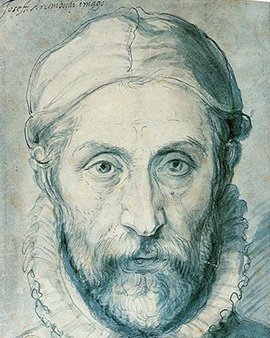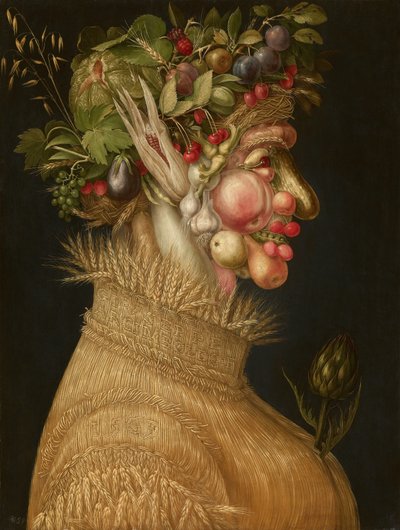Giuseppe Arcimboldo, also called Arcimbaldo or Arcimboldi, began his life in 1526 in Milan in subtle circles. His relatives included clergymen and lawyers, and his father Biacio helped design the interior of Milan Cathedral. Giuseppe was at his side, and this is mentioned in the files. The work begins in 1549, when he is 23 years old, and lasts for ten years.
At the age of 36, his talent for skilful portraits is so well known that he is appointed to the Viennese court. Under Ferdinand I, he began his work as a house portraitist, creating portraits of the ladies and gentlemen of the house. Photography had not yet been invented, so painters were needed who could present what they had seen in detail and in a way that would enhance the image. After 2 years he is appointed court painter.
Now his work is not limited to portraits; the privileged status gives him time for creative work. Here he created the world-famous cycles of the four seasons and the four elements, which he presented to the emperor on New Year's Day in 1569.
The following year he is ordered to Prague. A splendid festive procession is to be arranged. He creates imaginative interpretations of legends and myths, splendid and detailed. Costume garments representing the various professions, sleighs with delicate ornamentation and varied depictions of animals and, last but not least, horse harnesses and enchanting saddlecloths, everything should delight the hearts of the spectators. But his work is not limited to the idea. The design of colours and forms, the structure and coordination of all living beings involved are also in his hands. From now on he designs many celebrations and festivities for smaller and larger occasions.
At the age of almost 50 he becomes court painter to Emperor Rudolf II. Also under this gentleman the artistic design of vivid beauty is his department. The emperor's interests are devoted to science and the arts. Thus a lively exchange with colleagues in astrology and alchemy takes place. The kinship of colours and sounds moves him deeply. He dedicates all his passion to a scientific treatise on this subject and a museum project on the subject.
Finally, in 1587, at the age of 61, the emperor allowed him to travel home to Milan. His faithful services were previously honoured with nobility and coat of arms. At the age of 66, he was awarded the title of Court Palatine Count. Thus he died on 11 July 1593 at the age of 67 in his homeland and with high honours.
×





.jpg)
.jpg)
.jpg)
.jpg)
.jpg)
.jpg)
.jpg)
.jpg)
 1573 - (MeisterDrucke-92540).jpg)
 1573 - (MeisterDrucke-92540).jpg)
.jpg)
.jpg)
.jpg)
.jpg)
.jpg)
.jpg)
.jpg)
.jpg)
.jpg)
.jpg)
.jpg)
.jpg)
.jpg)
.jpg)
_Lo_-_(MeisterDrucke-1000672).jpg)
_Lo_-_(MeisterDrucke-1000672).jpg)
.jpg)
.jpg)
.jpg)
.jpg)
.jpg)
.jpg)
.jpg)
.jpg)
_Oil_on_canvas_ca_1566_Dimension_744x56_cm_-_(MeisterDrucke-995129).jpg)
_Oil_on_canvas_ca_1566_Dimension_744x56_cm_-_(MeisterDrucke-995129).jpg)
.jpg)
.jpg)
.jpg)
.jpg)
.jpg)
.jpg)
.jpg)
.jpg)
.jpg)
.jpg)
.jpg)
.jpg)


.jpg)
.jpg)
_16th_century_Sun_076x063_m_-_-_(MeisterDrucke-970100).jpg)
_16th_century_Sun_076x063_m_-_-_(MeisterDrucke-970100).jpg)
_1573_Dim_076x063_m_-_Summer_-_P_-_(MeisterDrucke-983886).jpg)
_1573_Dim_076x063_m_-_Summer_-_P_-_(MeisterDrucke-983886).jpg)
_(1527-1593)_1566_Dim_665x51_c_-_(MeisterDrucke-983746).jpg)
_(1527-1593)_1566_Dim_665x51_c_-_(MeisterDrucke-983746).jpg)
.jpg)
.jpg)
.jpg)
.jpg)
_16_-_(MeisterDrucke-1001542).jpg)
_16_-_(MeisterDrucke-1001542).jpg)
.jpg)
.jpg)
.jpg)
.jpg)
.jpg)
.jpg)
_Among_the_vegetables_and_fruits_represe_-_(MeisterDrucke-1033981).jpg)
_Among_the_vegetables_and_fruits_represe_-_(MeisterDrucke-1033981).jpg)
.jpg)
.jpg)
.jpg)
.jpg)
.jpg)
.jpg)
_(1527-1593)_1563_Dim_67x51_c_-_(MeisterDrucke-952928).jpg)
_(1527-1593)_1563_Dim_67x51_c_-_(MeisterDrucke-952928).jpg)
 - (MeisterDrucke-163550).jpg)
 - (MeisterDrucke-163550).jpg)
.jpg)
.jpg)
_Lo_-_(MeisterDrucke-1027182).jpg)
_Lo_-_(MeisterDrucke-1027182).jpg)
.jpg)
.jpg)
.jpg)
.jpg)
.jpg)
.jpg)
_-_(MeisterDrucke-899709).jpg)
_-_(MeisterDrucke-899709).jpg)
.jpg)
.jpg)
.jpg)
.jpg)
.jpg)
.jpg)
_-_(MeisterDrucke-1666651).jpg)
_-_(MeisterDrucke-1666651).jpg)
_with_his_family_Mary_of_Spain_(1528-1603)_and_-_(MeisterDrucke-948368).jpg)
_with_his_family_Mary_of_Spain_(1528-1603)_and_-_(MeisterDrucke-948368).jpg)
.jpg)
.jpg)
 - (MeisterDrucke-87847).jpg)
 - (MeisterDrucke-87847).jpg)
.jpg)
.jpg)
_Mu_-_(MeisterDrucke-952112).jpg)
_Mu_-_(MeisterDrucke-952112).jpg)
.jpg)
.jpg)
.jpg)
.jpg)
.jpg)
.jpg)
.jpg)
.jpg)
.jpg)
.jpg)
_-_(MeisterDrucke-1466440).jpg)
_-_(MeisterDrucke-1466440).jpg)
.jpg)
.jpg)
.jpg)
.jpg)
.jpg)
.jpg)
.jpg)
.jpg)
.jpg)
.jpg)
.jpg)
.jpg)
.jpg)
.jpg)
.jpg)
.jpg)
.jpg)
.jpg)
.jpg)
.jpg)
.jpg)
.jpg)
.jpg)
.jpg)
.jpg)
.jpg)
_-_(MeisterDrucke-1667043).jpg)
_-_(MeisterDrucke-1667043).jpg)
_Spring_Milan_Castello_Sforzesco_-_(MeisterDrucke-1025300).jpg)
_Spring_Milan_Castello_Sforzesco_-_(MeisterDrucke-1025300).jpg)
.jpg)
.jpg)
.jpg)
.jpg)
.jpg)
.jpg)
 - (MeisterDrucke-302640).jpg)
 - (MeisterDrucke-302640).jpg)
.jpg)
.jpg)
_-_(MeisterDrucke-1667224).jpg)
_-_(MeisterDrucke-1667224).jpg)
 - (MeisterDrucke-176113).jpg)
 - (MeisterDrucke-176113).jpg)
.jpg)
.jpg)
.jpg)
.jpg)
.jpg)
.jpg)
_-_(MeisterDrucke-1172261).jpg)
_-_(MeisterDrucke-1172261).jpg)
.jpg)
.jpg)
.jpg)
.jpg)
_1589_Madrid_Real_Academy_of_B_-_(MeisterDrucke-1024591).jpg)
_1589_Madrid_Real_Academy_of_B_-_(MeisterDrucke-1024591).jpg)
.jpg)
.jpg)
.jpg)
.jpg)
.jpg)
.jpg)
.jpg)
.jpg)
.jpg)
.jpg)
.jpg)
.jpg)
.jpg)
.jpg)
.jpg)
.jpg)
.jpg)
.jpg)






